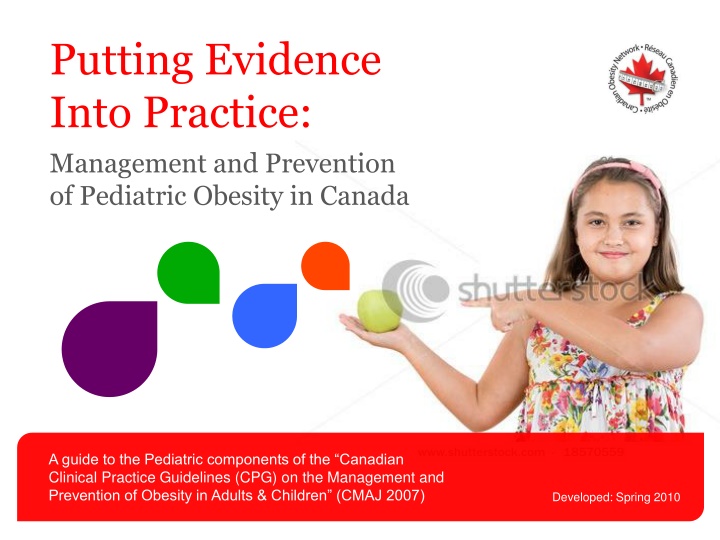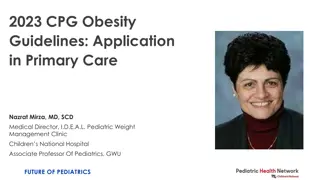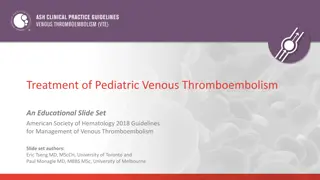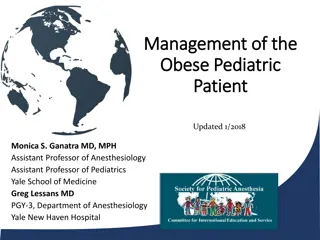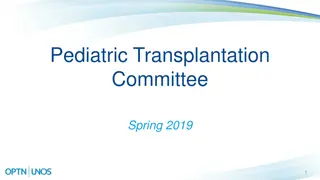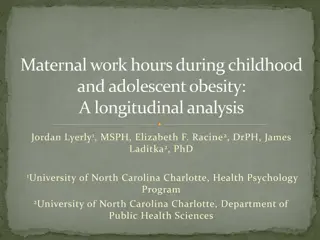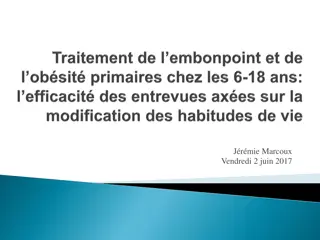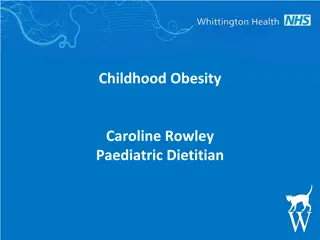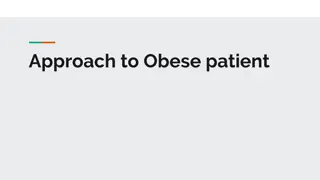Pediatric Obesity Management and Prevention Guidelines in Canada
This resource provides guidance on pediatric obesity management and prevention in Canada, based on the Canadian Clinical Practice Guidelines. It includes recommendations specific to the pediatric population, implementation strategies, and insights from content experts. The slides cover a range of topics related to the management and prevention of pediatric obesity, offering valuable insights for healthcare practitioners.
Download Presentation

Please find below an Image/Link to download the presentation.
The content on the website is provided AS IS for your information and personal use only. It may not be sold, licensed, or shared on other websites without obtaining consent from the author.If you encounter any issues during the download, it is possible that the publisher has removed the file from their server.
You are allowed to download the files provided on this website for personal or commercial use, subject to the condition that they are used lawfully. All files are the property of their respective owners.
The content on the website is provided AS IS for your information and personal use only. It may not be sold, licensed, or shared on other websites without obtaining consent from the author.
E N D
Presentation Transcript
Putting Evidence Into Practice: Management and Prevention of Pediatric Obesity in Canada A guide to the Pediatric components of the Canadian Clinical Practice Guidelines (CPG) on the Management and Prevention of Obesity in Adults & Children (CMAJ 2007) Developed: Spring 2010
Purpose The purpose of these slides is to create a tool for health care practitioners that: 1. Identifies the Canadian recommendations for obesity management and prevention that are specific to the pediatric population and; 2. Provides information on how to implement each recommendation This includes material directly from the Canadian Clinical Practice Guidelines (CPG) as well as supplementary information provided by the contributors based on their professional expertise. Management and Prevention of Pediatric Obesity in Canada 2
Slide Development Team Kathryn Ambler, MSc University of Alberta Geoff Ball, PhD, RD University of Alberta Tracey Bridger, MD Janeway Child Health Centre, Memorial University Sara Kirk, PhD Dalhousie University Katherine Morrison, MD McMaster University Management and Prevention of Pediatric Obesity in Canada Management and Prevention of Pediatric Obesity in Canada 3 3
Content Experts Geoff Ball, PhD, RD University of Alberta Sara Kirk, PhD Dalhousie University Tracey Bridger, MD Janeway Child Health Centre, Memorial University Claire LeBlanc MD, FRCPC University of Alberta Laurent Legault, MD Montreal Children's Hospital JP Chanoine, MD, PhD British Columbia Children s Hospital Katherine Morrison, MD McMaster University Linda Gillis, MSc, RD McMaster Children s Hospital ZubeenPunthakee, MD FRCPC, ABIM McMaster University StasiaHadjiyannakisBSc, MD Children's Hospital of Eastern Ontario Tracy HusseyMSc, RD Hamilton Family Health Team Elizabeth Sellers MSc, MD University of Manitoba Management and Prevention of Pediatric Obesity in Canada 4
Acknowledgements Canadian Obesity Network (CON) Treatment and Research of Obesity in Pediatrics In Canada (TROPIC) Maternal, Infant, Child and Youth Research Network (MICYRN) Ashlee Pigford, University of Alberta Tarra Penney, Dalhousie University Greg Hayward,Dalhousie University Vision Creative Inc. Management and Prevention of Pediatric Obesity in Canada 5
Table of Contents 1. Pediatric Obesity in Canada: Epidemiology, Etiology and Risks 2. Role of Health Professionals: Evaluating and Managing Obesity 3. A Systematic Approach to Managing and Preventing Childhood Obesity 4. Recommendations for Managing Childhood Obesity 5. Case Study: Michael 6. Recommendations for the Prevention of Childhood Obesity 7. Summary and Conclusion Management and Prevention of Pediatric Obesity in Canada 6
Index of Recommendations 1. Role of health professionals 2. Classification of overweight and obesity in children and adolescents 3. Clinical evaluation of obese children and adolescents 4. Assessment of Readiness to Change 5. Lifestyle Modification 1. Behaviour Therapy 2. Dietary Interventions 3. Physical Activity Interventions 4. Combined Dietary and Physical Activity Interventions 5. Pharmacotherapy 6. Surgery 7. Alternative Interventions 6. Prevention: Childhood nutrition 7. Prevention: Physical Activity/Reduced Sedentary Behaviour 8. Higher level prevention strategies Management and Prevention of Pediatric Obesity in Canada 7
Management and Prevention of Pediatric Obesity in Canada 1 Pediatric Obesity in Canada: Epidemiology, Etiology and Risks
Pediatric Obesity in Canada: Epidemiology, Etiology and Risks 1 Childhood Obesity in Canadian Children 3-fold increase in obesity in Canadian children 9 Obesity prevalence (%) 8 7 Based on measured heights and weights in representative Canadian sample 6 1979 2004 5 4 3 Classified by BMI 95th percentile 2 1 0 Girls Boys Shields, 2005 Management and Prevention of Pediatric Obesity in Canada 9
Pediatric Obesity in Canada: Epidemiology, Etiology and Risks 1 Etiology Etiology for the development of obesity in childhood is complex and multifactorial Balance of input (through nutrient intake) and output (through physical activity) is fundamental but understanding the underpinnings of these is most important Recognized determinants for the development of obesity occur across the lifespan and both genetics and environment are critical Management and Prevention of Pediatric Obesity in Canada 10
Pediatric Obesity in Canada: Epidemiology, Etiology and Risks 1 Obesity and Children s Health Ebbeling et al., 2002 Ebbeling et al., 2002 Management and Prevention of Pediatric Obesity in Canada 11
Management and Prevention of Pediatric Obesity in Canada 2 Role of Health Professionals: Evaluating and Managing Obesity
Role of Health Professionals: Evaluating and Managing Obesity 2 R Recommendation: Role of Health Professionals Management and Prevention of Pediatric Obesity in Canada 13
Role of Health Professionals: Evaluating and Managing Obesity 2 R: Role of Health Professionals Health care professionals are encouraged to: Work with other health care team members to develop a comprehensive program for the patient Create a non-judgmental atmosphere Consider barriers people might have [grade C, levels 3 & 4] Complete Guidelines Complete Guidelines Management and Prevention of Pediatric Obesity in Canada 14
Role of Health Professionals: Evaluating and Managing Obesity 2 Multidisciplinary Health Care Teams Can be used with individuals or with groups Include: Medical practitioner (Nurse, family physician or specialist) Psychologist Dietician Exercise Professional Others Management and Prevention of Pediatric Obesity in Canada 15
Role of Health Professionals: Evaluating and Managing Obesity 2 Attitudes toward overweight and obesity Many overweight and obese people experience negative bias and discrimination They may be reluctant to seek health care because of fear of scolding or humiliation Stereotypes and prejudices held by health care professionals can compromise care Management and Prevention of Pediatric Obesity in Canada 16
Role of Health Professionals: Evaluating and Managing Obesity 2 Creating a non-judgmental atmosphere SUPPLEMENTARY INFORMATION Limit medical jargon Use neutral body language Speak with both the child and parent Avoid blaming Management and Prevention of Pediatric Obesity in Canada 17
Role of Health Professionals: Evaluating and Managing Obesity 2 Considering Barriers SUPPLEMENTARY INFORMATION Focus on the family s agenda, not your own Seek out experienced colleagues to provide honest feedback Increase knowledge and clinical skills through continuing education in therapeutic techniques, including motivational interviewing and cognitive behavioural therapy Management and Prevention of Pediatric Obesity in Canada 18
A Systematic Approach to Managing and Preventing Childhood Obesity 3 A Systematic Approach to Managing and Preventing Childhood Obesity
A Systematic Approach to Managing and Preventing Childhood Obesity 3 A Systematic Approach to Managing and Preventing Childhood Obesity PERFORM BMI SCREENING (ALL YOUTH) If 85th percentile If <85th percentile TAKE MEDICAL HISTORY AND CONDUCT PHYSICAL EXAMINATION FOCUS ON OBESITY Abnormality(ies) Present Abnormality(ies) Absent Individual Approaches: Policy Approaches TEST FOR SPECIFIC GENETIC OR ENDOCRINE CONDITIONS PHYSICAL ACTIVITY Individual Approaches: Environmental Approaches ASSESS READINESS TO CHANGE NUTRITION LIFESTYLE MODIFICATION APPROPRIATE TO SITUATION FOLLOW UP Management and Prevention of Pediatric Obesity in Canada 20
Recommendations for Managing Childhood Obesity 4 Recommendations for Managing Childhood Obesity
Recommendations for Managing Childhood Obesity 4 Classification of Overweight and Obesity in Children and Adolescents PERFORM BMI SCREENING (ALL YOUTH) If 85th percentile TAKE MEDICAL HISTORY AND CONDUCT PHYSICAL EXAMINATION Abnormality(ies) Present Abnormality(ies) Absent TEST FOR SPECIFIC GENETIC OR ENDOCRINE CONDITIONS ASSESS READINESS TO CHANGE LIFESTYLE MODIFICATION APPROPRIATE TO SITUATION FOLLOW UP Management and Prevention of Pediatric Obesity in Canada 22
Recommendations for Managing Childhood Obesity 4 R Recommendation: BMI Screening Management and Prevention of Pediatric Obesity in Canada 23
Recommendations for Managing Childhood Obesity 4 R: BMI Screening We recommend: measuring BMI in all children and adolescents (aged 2 years and older). using the growth charts of the US Centers for Disease Control and Prevention to screen for overweight and obesity Overweight: Age and sex-specific BMI 85th and <95th percentile Obesity: Age and sex-specific BMI 95th percentile [grade A, levels 3] Complete Guidelines Complete Guidelines Management and Prevention of Pediatric Obesity in Canada 24
Recommendations for Managing Childhood Obesity 4 Measuring Height and Weight in Children Height Should be measured to the nearest centimetre using a stadiometer. The patient should look straight ahead, stand as tall as possible and take a deep breath while the measurement is taken. Weight Should be measured to the nearest 0.1 kg with an accurate, well-maintained physician s scale. The patient should be weighed in light clothing, without footwear. Management and Prevention of Pediatric Obesity in Canada 25
Recommendations for Managing Childhood Obesity BMI Charts for Children (US Center for Disease Control & Prevention, CDC) 4 CJ41L023 CJ41L024 Available online at: www.cdc.gov/growthcharts Available online at: www.cdc.gov/growthcharts Management and Prevention of Pediatric Obesity in Canada 26
Recommendations for Managing Childhood Obesity 4 Other Classification Systems SUPPLEMENTARY INFORMATION Other resources are available for categorizing children and youth into different BMI groups. International Obesity Task Force (Cole et al., 2000) WHO Growth Curves (http://www.who.int/childgrowth/en/) Waist Circumference Among children and adolescents, waist circumference is a good predictor of other measures of adiposity and risk level for heart disease. Further research is required to determine the clinical utility of waist circumference and its association with health risks independent of BMI. Management and Prevention of Pediatric Obesity in Canada 27
Recommendations for Managing Childhood Obesity 4 Clinical Evaluation of Obese Children and Adolescents PERFORM BMI SCREENING (ALL YOUTH) If 85th percentile TAKE MEDICAL HISTORY AND CONDUCT PHYSICAL EXAMINATION Abnormality(ies) Present Abnormality(ies) Absent TEST FOR SPECIFIC GENETIC OR ENDOCRINE CONDITIONS ASSESS READINESS TO CHANGE LIFESTYLE MODIFICATION APPROPRIATE TO SITUATION FOLLOW UP Management and Prevention of Pediatric Obesity in Canada 28
Recommendations for Managing Childhood Obesity 4 R Recommendation: Clinical Evaluation Management and Prevention of Pediatric Obesity in Canada 29
Recommendations for Managing Childhood Obesity 4 R: Clinical Evaluation We recommend that: The clinical evaluation of overweight and obese children include a history and a general physical examination to exclude: Secondary causes (endocrine-or syndrome-related) Obesity-related health risks and complications [grade A, levels 3] In overweight or obese children, a fasting plasma glucose and lipid profile should be performed in those 10 years of age [grade B, levels 3] Complete Guidelines Complete Guidelines Management and Prevention of Pediatric Obesity in Canada 30
Recommendations for Managing Childhood Obesity 4 R Recommendation: Clinical Evaluation 1. Identification of risk factors for the development of obesity Management and Prevention of Pediatric Obesity in Canada 31
Recommendations for Managing Childhood Obesity 4 Medical History Does past Family History include obesity and obesity related disorders? Does pregnancy history include maternal diabetes, pregnancy exposures or low birthweight What was infant feeding history? Management and Prevention of Pediatric Obesity in Canada 32
Recommendations for Managing Childhood Obesity 4 Additional Medical History Considerations SUPPLEMENTARY INFORMATION What is the child s developmental history? Does medical history include growth delay, asthma, or treatment for previous childhood cancer? What is the pattern of weight gain? Psychosocial history Screen for depression and eating disorders Assess quality of life Past or current medications Management and Prevention of Pediatric Obesity in Canada 33
Recommendations for Managing Childhood Obesity 4 Physical Activity and Nutrition Patterns of Physical Activity Time spent watching television, using the computer and playing video games Low participation in physical activities Nutritional Intake High sugared drink intake Low fruit and vegetable intake Disordered eating patterns Management and Prevention of Pediatric Obesity in Canada 34
Recommendations for Managing Childhood Obesity 4 Physical Activity Considerations SUPPLEMENTARY INFORMATION Physical Activities Frequency (minutes per day) Weekdays vs. weekends Seasonal variation Type of activities (level of moderate to vigorous physical activity) With whom (friends, family, alone) Sedentary Activities Total screen time Television Average per day Is there a TV in the bedroom? Leisure time computer and video games Average per day Active video games (Wii, Dance Dance Revolution) Management and Prevention of Pediatric Obesity in Canada 35
Recommendations for Managing Childhood Obesity 4 Nutritional Intake Considerations SUPPLEMENTARY INFORMATION Can be assessed using a 24 hour recall (or typical day recall) and/or a food frequency questionnaire Nutritional Patterns what is the frequency of: Eating meals together as a family? Eating fast food/eating out? Eating in front of the TV? Eating breakfast? Management and Prevention of Pediatric Obesity in Canada 36
Recommendations for Managing Childhood Obesity 4 Other Considerations SUPPLEMENTARY INFORMATION Sleeping patterns Mental health of all family members Psychosocial family dynamics Socioeconomics Environment factors (home / school / community) Management and Prevention of Pediatric Obesity in Canada 37
Recommendations for Managing Childhood Obesity 4 R Recommendation: Clinical Evaluation 2. Exclusion of Secondary Causes of Obesity Management and Prevention of Pediatric Obesity in Canada 38
Recommendations for Managing Childhood Obesity 4 Secondary Causes of Obesity Endocrine causes associated with attenuated linear growth or a history of central nervous system injury Genetic syndromes usually early onset often associated with neurodevelopmental delay may be associated with dysmorphic features Management and Prevention of Pediatric Obesity in Canada 39
Recommendations for Managing Childhood Obesity 4 Overview of History and Physical Exam for an Overweight or Obese Child: evaluation of genetic or endocrine causes History (personal and family) Physical Exam Absence of Dysmorphic features Presence of Dysmorphic features Assessment of Growth Velocity Chromosomal typing, molecular biology Abnormal Normal Possible Endocrine Disorder: Rule out hypothyroidism, GH deficiency, and Cushings Exogenous, primary, simple obesity Management and Prevention of Pediatric Obesity in Canada 40
Recommendations for Managing Childhood Obesity 4 R Recommendation: Clinical Evaluation 3. Physical Exam and Identification of Obesity Related Co-morbities Management and Prevention of Pediatric Obesity in Canada 41
Recommendations for Managing Childhood Obesity 4 Aspects of the Physical Exam SUPPLEMENTARY INFORMATION In addition to measuring height and weight and calculating BMI, the physical exam may investigate: Blood pressure Presence of acanthosisnigricans Hirsutism and excessive acne (females) Orthopedic concerns Management and Prevention of Pediatric Obesity in Canada 42
Recommendations for Managing Childhood Obesity 4 Recommended Laboratory Investigations For children 10 years old and older: Fasting plasma glucose Total cholesterol LDL cholesterol HDL cholesterol HDL: total cholesterol Management and Prevention of Pediatric Obesity in Canada 43
Recommendations for Managing Childhood Obesity 4 Suggested Laboratory Investigations SUPPLEMENTARY INFORMATION Oral Glucose Tolerance Test ALT and AST Alkaline phosphatase Albumin Creatinine Free testosterone, luteinizing hormone, and follicle stimulating hormone (females) Management and Prevention of Pediatric Obesity in Canada 44
Recommendations for Managing Childhood Obesity 4 Obesity Related Co-Morbities Many of the obesity-related comorbidities recognized in adulthood begin to develop in childhood: Cardiovascular (hypertension) Metabolic (dyslipidemia, dysglycemia, type 2 diabetes) Respiratory (obstructive sleep apnea) Gastrointestinal (nonalcoholic fatty liver disease, cholelithiasis, gastroesophageal reflux) Orthopedic (slipped capital femoral epiphysis, tibia vara [Blount disease], musculoskeletal discomfort) Reproductive (polycystic ovary syndrome) Psychosocial (poor self-esteem, depression) Renal (focal segmental glomerulosclerosis) Management and Prevention of Pediatric Obesity in Canada 45
Recommendations for Managing Childhood Obesity 4 Determination of Obesity Related Co-morbities Obesity related health consequence Hypertension Obstructive sleep apnea Recommended assessment Serial blood pressure measurements Hx: snoring, am headache, excess daytime fatigue, Consider sleep study History, physical exam, ALT & AST levels History History, laboratory Nonalcoholic fatty liver disease (NAFLD) Gastroesophageal reflux Gallstones Management and Prevention of Pediatric Obesity in Canada 46
Recommendations for Managing Childhood Obesity 4 Determination of Obesity Related Co-morbities Obesity related health consequence Slipped capital femoral epiphysis Tibia vara (Blount s disease) Spondylolisthesis Axial arthritis Polycystic ovary syndrome Recommended assessment History, Physical History, Physical History, physical exam History History(menstrual irregularity, 2 amenorrhea) Physical (hirsutism, acne) Laboratory (LH, FSH, free testosterone, pelvic ultrasound) History History History Depression Low self-esteem Binge-eating disorder Management and Prevention of Pediatric Obesity in Canada 47
Recommendations for Managing Childhood Obesity 4 Determination of Obesity Related Co-morbities Diabetes screening: For children 10 years if they have 2 of the following risk factors: member of a high-risk ethnic group family history of type 2 diabetes (especially if the child was exposed to diabetes in utero) acanthosisnigricans polycystic ovarian syndrome hypertension dyslipidemia Should be done every 2 years using a fasting plasma glucose test. An oral glucose tolerance test may also be considered as a screening test. Management and Prevention of Pediatric Obesity in Canada 48
Recommendations for Managing Childhood Obesity 4 Assessment of Readiness to Change PERFORM BMI SCREENING (ALL YOUTH) If 85th percentile TAKE MEDICAL HISTORY AND CONDUCT PHYSICAL EXAMINATION Abnormality(ies) Present Abnormality(ies) Absent TEST FOR SPECIFIC GENETIC OR ENDOCRINE CONDITIONS ASSESS READINESS TO CHANGE LIFESTYLE MODIFICATION APPROPRIATE TO SITUATION FOLLOW UP Management and Prevention of Pediatric Obesity in Canada 49
Recommendations for Managing Childhood Obesity 4 R Recommendation: Readiness to Change Management and Prevention of Pediatric Obesity in Canada 50
